
Professional HD Quality
Progressive 3CCD and
2/3-Inch Interchangeable Lens System
The
The camera process scans at full 1080/60 (or 50) progressive frames a second. It is this initial capture that is the foundation for all of the formats that this camera generates. While the camera does not record 1080P/60(or 50), the signals start there and are either cross converted or down converted to the format being utilized that day.
* The effective image size of the CCD is equivalent to 2/3.2 inches.
Chromatic Aberration Compensation (CAC)
Chromatic Aberration Compensation (CAC) function is a new feature in the
Full screen image (simulated**) | CAC OFF (simulated**) CAC ON (simulated**) |
Progressive 3CCD
The
Interlace scanning frame image (simulated**) Progressive scanning frame image (simulated**)
A.P.T for Higher Image Quality
Advanced progressive technology (A.P.T) produces higher total image quality by linking the progressive 3CCD camera system with a
The R, G and B color signals from the 3 CCDs are then sent through a
* Called an advanced offset spatial process.
A.P.T (Advanced Progressive Technology)
R |
|
| HD/SD |
G |
| Format | |
| |||
B | A/D | DSP |
|
|
| ||
Progressive CCD |
| Recording | |
| processing) | ||
CCD Aquisition | Advanced Offset Spacial Process |
| |
|
| 1080/60P (50P) Signal Process |
|
**“Simulated” images were produced in order to describe the function. It is not a screen capture of an actual image. It differs from an actual image in that the effect of the function has been emphasized for easier understanding.
